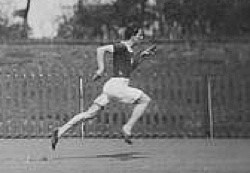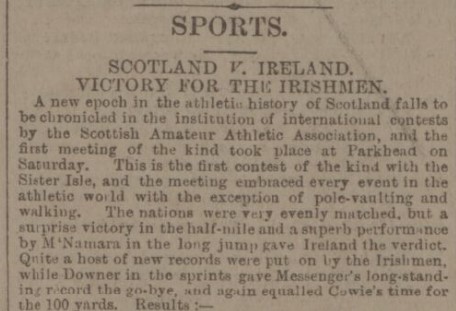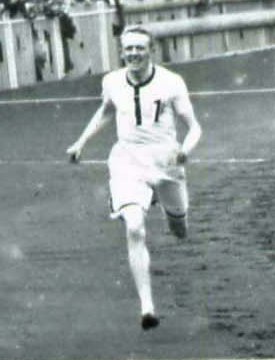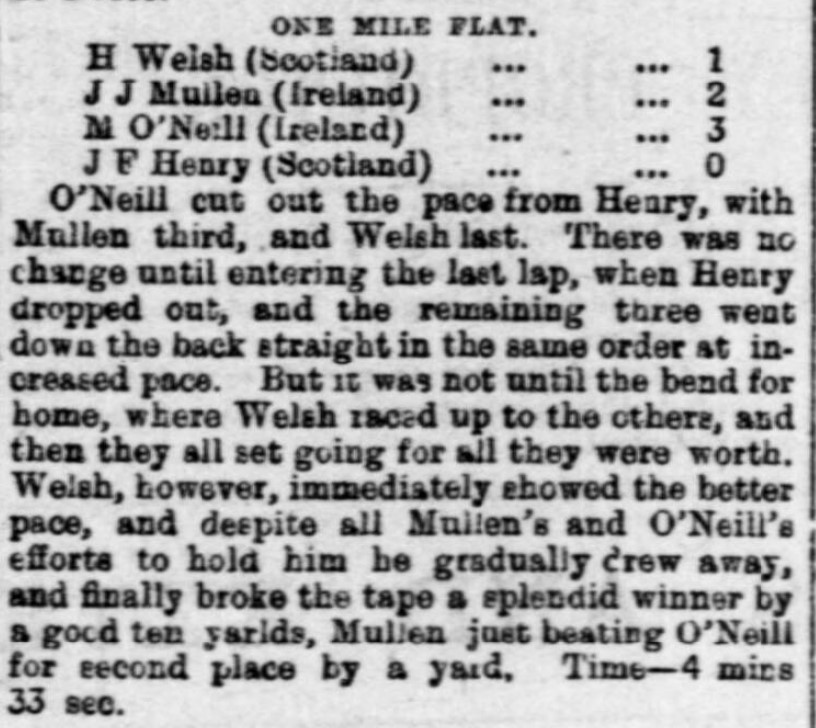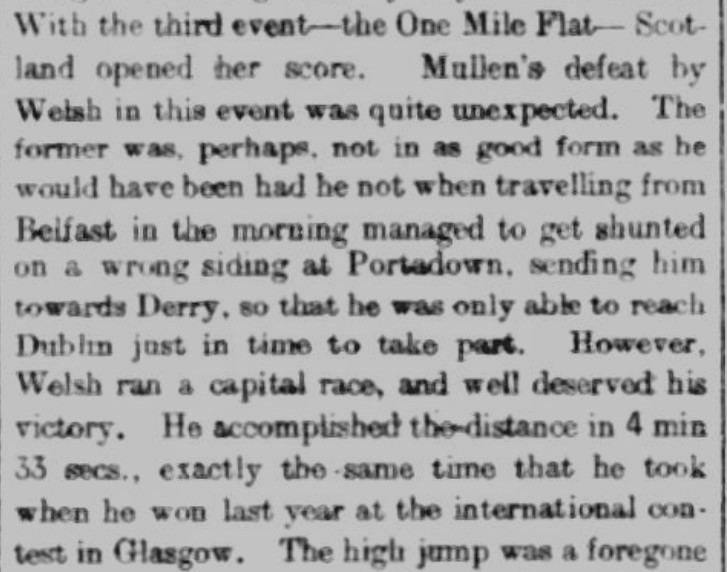AR Downer
Athletes always want to test themselves against the best opposition that they can find. The Scottish Amateur Athletic Association was founded in 1883 and it was natural that after testing themselves against the best in the country, the top athletes would want to go further afield in search of competition. So it was that in 1891 the international with Ireland was born. The full story is told in “Fifty Years of Athletics” at http://www.anentscottishrunning.com/scotland-v-ireland-a-retrospect/ by DA Jamieson.
“In July 1891 a special meeting of the General Committee of the Scottish AAA was convened to consider a proposal which had been received from the Irish AAA inviting a team of representative Scottish athletes to take part in a series of races against selected representatives of the Irish Association. The distances suggested for competition were 100 yards, 440 yards and One Mile, and it was further suggested that this series of races should form the crowning feature of the Irish All-Round Championship Meeting which was to be held at Balls Bridge, Dublin, on 15th August of that year. The proposed conditions of the contest were that the Irish Association should provide the prizes, whilst the Scottish body were to defray their own expenses.
In spite of its allurement, however, this invitation was declined by the Scottish AAA; but the potentialities of such a contest were perceived by the Scottish executive, and accordingly the Honorary Secretary was instructed top open negotiations for the institution of an international contest on a broader basis than the original suggestion – namely, to embrace all championship events. The question of guarantees was also raised, and it was suggested that these should be given by each country in turn. In this manner, then, was laid the foundations of an International athletic contest with Ireland, which was to continue without interruption for nearly twenty years. But although the foundations were truly laid in 1891 through force of circumstances the edifice itself was not erected until four years later.
It was not until December of 1894 that overtures were again made by the IAAA to the SAAA with regard to instituting an annual athletic contest between the countries on the lines of the Oxford v Cambridge match, in which the odd event in eleven items was to decide the winner.
This proposal was cordially accepted by the SAAA executive with the following suggestions: (1) That the first contest be held in Scotland; (2) That a guarantee be given to the visiting team to cover expenses; (3) That the programme of events to be decided should be the Scottish championship events – the Ten Miles excepted; each country to have two representatives in each event, with three in the Four Miles race; and (4) that in Scotland the Hammer to be thrown in the Scottish style and in Ireland under Irish rules.
In the main, agreement was reached on all these points.”
The first international was contested on 20th July, 1895 in Glasgow and from the Scottish point of view, the star of the meeting was Alf Downer of the Scottish Pelicans AC. Downer won the 100, 220 and 440 yards and in a contest where the winning team was decided by the number of events won, all three counted for the SAAA team. The report in the “Glasgow Herald” read as follows.
“As a display of athleticism the contest between Scotland and Ireland is the richest of the season; indeed in some respects it will stand out as the most brilliant example of running and physical effort that has even been witnessed in Scotland. For proof of this one only has to analyze carefully the results of the different competitions, and he will find four performances which surpass all amateur efforts in this country, and another two which tie with all-comers records. The only regret with regard to these performances is that three were accomplished by Irishmen, the other one being the work of AR Downer who has done so much this season to raise Scottish athletics in the eyes of other nations. The Scottish Pelican’s triple performance on Saturday is perhaps the first ever accomplished by an amateur athlete. He won the 100 yards in 10 seconds, which ties with the Scottish record; in the 220 he reduced his own record – 22 2-5th seconds – which he made a week ago today at the Edinburgh University Sports by a fifth of a second; and in the quarter he equalled JM Cowie’s record – 51 1-5th seconds. These performances speak for themselves; they are unique in the sense that they have never been equalled or even approached at one competition by any amateur in Britain. TF Kiely, the all-round champion of Ireland, took part in three events – (1) the hurdles in which he ran third; (2) the hammer in which he was second with 100′ 6″; (3) the long jump in which he lowered the Scottish record by doing 22′ 2 1-2″, the previous best being 21′ 11” by T Vallance which stood since 1881. As an individual effort, these three performances rank next to Downer’s for general excellence.
JJ Mullen of the Elysian Harriers comes next with a first in the four mile and a second in the mile. H Welsh created a surprise by defeating Mullen in the mile; but as the Irishman was recovering from a sharp illness, it is evident that this, like the majority of events, would have fallen to our rivals. We cut a poor appearance in the half mile; indeed but for Downer, we would have been very badly beaten in the track events. It was he who saved Scotland from a very humiliating defeat. Even in regard to second positions, Ireland showed to much better advantage than Scotland, in fact we may regard ourselves as exceedingly fortunate in only losing by 6 events to 5 as all round the Irish team disclosed greater ability than the Scots.
The meeting we have only to add marks a new and interesting departure in International athletics, and from the impression which the whole display created on Saturday, we venture to predict a brilliant future to our match with Ireland. The event on Saturday was shorn of much of its brilliance on account of the athletic rupture which deprived Scotland of several of our best men, but by next year it is to be hoped we will be living under happier conditions, and that with a thoroughly representative team we will be able to reverse Saturday’s result. The SAAA scored an athletics success on Saturday at Parkhead, and although the financial returns were disappointing, it is well known that the holidays and political excitement kept many away who would otherwise have been present.”
The “Courier” had a slightly different slant on the day’s procedings:
The results on the day were:
100 yards: 1. AR Downer (S) 10.0 seconds; 2. P McNamara (I) 220 yards: 1. AR Downer (S) 22.25 sec; 2. JT Magee (I)
440 yards: 1. AR Downer (S) 51.2 seconds; 2, JT Magee (I); 880 yards 1. J Archer (I) 2:04.2; 2. J Stirton (S)
Mile: 1. H Welsh (S) 4:33; 2. JJ Mullen (I); Four Miles: 1. JJ Mullen (I); P McMorrow (S)
120 y hurdles: 1. JAE Mulligan (I) 16.8 seconds; 2. AL Graham (S)
High Jump: 1. JM Ryan (I) 6′ 1″; 2. C Fenwick (S); Broad Jump: 1. TF Kiely (I) 22′ 2 1/2″; 2. P McNamara (I)
Putting the Weight: 1. D Horgan (I) 44′ 7′; 2. JD McIntosh (S); Throwing the Hammer: 1. D Ross (S) 101′; 2. TF Keily (I)
Hugh Welsh
The split referred to above was about a dispute within Scottish Athletics when there were two rival bodies – the SAAA and the SAAU – in existence in 1895 and 1896 with only SAAA athletes eligible to compete in this fixture. The 1896 meeting between the two countries was held at Balls Bridge, Dublin on 18th July and the Scottish team was weaker in that Downer was not available. With a year’s more running behind him, Welsh was running better but the final score was Ireland 7 Scotland 4 events.
The Irish papers previewed the event for the entire week leading up to it and it was an event that both countries were looking forward to. The Cork Examiner not only had a short report on the meeting on Monday 20th but a short detailed account of every single event with every athlete’s times and performances noted. The report read:
“INTERNATIONAL ATHLETICS
Ireland Beats Scotland
Yesterday the great Inter National contest between Ireland and Scotland was decided at Balls Bridge. Last year at Glasgow when the countries met for the first time Ireland won by six events to five, and yesterday the victory was repeated when the Irishmen secured seven to the Scotchmen’s four. The day was very favourable to the affair which was patronised by an excellent crowd. It was almost a foregone conclusion that the Ireland would win, but still the contest was exciting to the very end. The event which roused most excitement was the 1 mile at which the Scotchman Welsh beat Mullen last year and yesterday he repeated the performance in gallant style, proving himself a really wonderful runner, of which he gave another proof later on when he won the half-mile in rare fashion. Mullen, it should be said, was not in good form, and consequently did not turn out in the four miles which saw the closest finish of the day. O’Neill, the County Limerick man, ran a very plucky race, and it was only after a desperate set to that the Scotchman Hay beat him by about a yard; but it must be said that with a little more experience, O’Neill might have reversed the result. Horgan, of Banteer, of course, won the shot, and Ryan, of Tipperary, gave a grand exhibition in the high jump. It was his first appearance of the year, and in fact it is said to be his first time to wear a shoe. For all he was almost at his very best, as evidenced by the fact that he cleared 6′ 2″, and it may be said that he actually cleared 6′ 3″, but the wind blew down the bar. It was a great disappointment that Flanagan did not turn up for the Hammer, for so far he has never competed in Dublin. In the quarter mile Meredith tied with the Irish record, which he also tied with on Whit Monday last. The other events are dealt with in the details.”
As an example of the details of the events Welsh’s win in the Mile is reproduced below:
Every event was covered in the same fashion. Mullen? The Irish Daily Express explained what had happened to Mullen in the Mile when it reported
The Glasgow Herald however described the race as a very bad one from an Irish point of view with O’Neill repeatedly getting in front of Mullen and not letting him past. It also described Mullen as ‘palpably unfit’ which maybe got nearer the truth of the matter. Results :
100 yards: 1. ND Morgan (I) 10.6 seconds; 2. H Barr (S) ; 220 yards: 1. ND Morgan (I) 23.4 seconds; 2. H Barr (S)
440 yards: 1. JC Meredith (I) 51.0 sec; 2. GC Thomson (S); 880 yards: 1. H Welsh (S) 2:01.4; 2. JE Finnegan (I)
Mile: 1. H Welsh (S) 4:33.0; 2. JJ Mullen (I); Four Miles: 1. RA Hay (S) 22:19; 2. M O’Neill (I)
120 yards hurdles: 1. D Carey (I) 16.6 seconds; 2. AB Timms (S) .
High Jump: 1. J Ryan (I) 6′ 2″; 2. W Grieve (S); Broad Jump: 1. H Barr (S) 22′ 5″; 2. WJ Newburn (I)
Putting the Weight: 1. D Horgan (I) 44′ 7″; 2. JD McIntosh (S); Throwing the Hammer: 1. JS Reynolds (I) 128′ 1″; 2. D Horgan (I)
Scotland again put out a weakened team. eg Hugh Barr was a very good long jumper (Scottish record holder and several times champion) and a good sprinter but not recognised as of the top flight. He did well getting two seconds as well as the win in the broad jump.
Two matches, two Irish victories.
